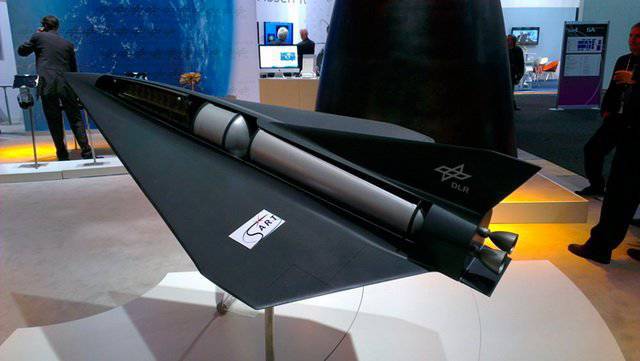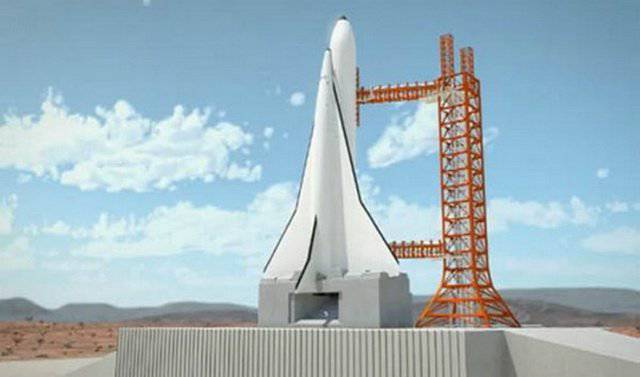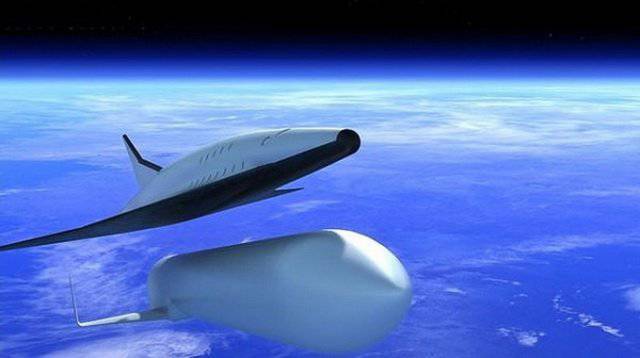Space passenger plane to the 2050 year: myth or reality
Sooner or later, the evolutionary path of development in the field of air travel should be replaced by a revolutionary path, the modernization of existing aircraft costs their manufacturers more and more. The effectiveness of the modernization of existing aircraft is approaching the physical limit. Rolf Henck agrees with this statement. The head of the air traffic control department at the German Aerospace Center (DLR). Modern aircraft becomes very difficult to improve. Given this, 2 problems arise: all new pilot projects at the time of their implementation may show a worse result compared to proven old ones; However, manufacturers still have little incentive to begin to implement their stunning concepts in life.
Mind-blowing ideas are currently only needed for working with the public. So, for example, the staff of the German Aerospace Center demonstrates their new project SpaceLiner. This name was given to the project of a rocket plane, which is filled with oxygen and hydrogen and is able to deliver passengers from Australia to Europe in 90 minutes. But even in the medium term, such extraordinary projects are unlikely to play any significant role in the air transportation of goods and passengers. Henke, head of the German Aerospace Center, admits that fantastic supersonic airplanes are most likely not a solution to future problems.

Despite this, the institute of space systems of the German Aerospace Center continues to promote its own concept of a hypersonic airliner. Scientists from a number of European countries, including Germany, Austria, Belgium, Spain, Italy, the Netherlands, France and Sweden, completed the next stage of research in order to develop future high-speed high-altitude transport being created as part of the Fast20XX project. The results of this project should be embodied in the 2-x programs to create hypersonic aircraft SpaceLiner DLR and ALPHA Innovation GmbH. Previously, 2050, such aircraft are unlikely to rise into the sky, but the technologies necessary for their creation are already being created.
One of the most important issues in creating such vehicles is cooling the hull. After acceleration, due to friction against the atmosphere of the planet, the SpaceLiner case will be heated to + 1800 degrees Celsius. To cool the leading edge of the wings and the nose of a hypersonic plane, German engineers suggest using active cooling based on porous ceramic materials with water circulating inside them. The remaining parts of the aircraft fuselage are planned to be covered with more traditional materials.
Today, in a plasma tunnel located in the DLR laboratory in Cologne, successful tests of porous ceramics and evaporative cooling systems have already passed. In addition, work is carried out on computer simulation of air flow near the aircraft. This work is very important, since SpaceLiner will reach very high flight altitudes, at which the atmospheric pressure is extremely low and conditions exist that are very different from those experienced by ordinary subsonic passenger aircraft.
In turn, the ALPHA project is different from SpaceLiner and is a transport system that should include an Airbus A330 carrier aircraft, as well as a hypersonic device launched from it. A small device with one pilot and two passengers on board should be separated from the aircraft carrier at an altitude of 14 km., After which it should independently climb to 100 km. Thus, ALPHA is primarily a transport for scientific or tourist suborbital flights.
SpaceLiner will be able to transfer up to 50 passengers from Australia to Europe in 90 minutes or 100 passengers from Europe to California in 60 minutes. In order to meet this time frame, the aircraft must fly at a speed of M = 24 or 25 km / h, while the flight is performed at altitudes of up to 200 km. Martin Zippel, Project Coordinator at the German Center aviation and astronautics (DLR), said that SpaceLiner is a kind of second coming of Space Shuttle, but having a fundamentally different task. It is worth noting that a comparison with shuttles, which even during the development period were not considered the most successful project, speaks of the Germans' confidence in the implementation of their plans.

Currently, there is information that SpaceLiner will use vertical takeoff, using for this purpose closed-cycle rocket engines on oxygen and liquid hydrogen. Its length is expected to be about 70 meters, wingspan - 40 meters, maximum take-off weight in the area of 1250 tons. The maximum flight range is estimated at 16 500 km. According to the figures, we have a typical German project: expensive, fast, and yet again expensive. If you count out anywhere from 12,5 to 25 tons of aircraft weight per passenger 1. However, the creators of the spacecraft and do not hide the fact that they are not going to transport regular visitors to the institutions for the distribution of free soup. The project for the construction of this aircraft is commercial, according to them, in the next 10 years, the German Center for Aviation and Cosmonautics will be able to find commercial partners for the implementation of its plans.
Currently, there is very little concrete about this project. Only a few details are known. In particular, it is reported that after acceleration — the active part of the trajectory and the start of planning — the situation with the ship’s controllability will be better than that of the shuttles due to the realization of a higher aerodynamic quality of the vehicle. For someone, the pointed nose of the hypersonic liner is also puzzling. It has been known for a long time that at speeds over M = 5 it does not give any significant advantages over rounded ones.
However, German developers are radiant with optimism: the final form of the new aircraft has not yet been determined and can be substantially adjusted. In this case, the Germans are going to guaranteed to bypass their competitors from other countries who are going to use open-cycle hypersonic engines that take air from the atmosphere of the Earth. True, such aircraft need to carry a smaller amount of fuel, and this reduces the cost of such projects, but they prefer to keep silent about such trifles in the DLR. At the same time, the closed cycle is best suited for high flight speeds and is already well developed, with no fundamentally new technologies to be created. The developers emphasize that they are not going to increase the efficiency of the engine, they chose to focus their forces on its repeated use.

The first stage of the hypersonic SpaceLiner, after the fuel has been developed, will descend to the ground by parachute near the launch site (due to the vertical take-off of the vehicle). On the ground, the stage can immediately be prepared for re-launch. Mnogorozavist of the first stage of the apparatus is a prerequisite for the German project. The integrated spacecraft engines will only provide a constant speed already on the high part of the trajectory.
Based on the available information, this project raises many questions. At such speeds, the flight taking off and landing over densely populated areas is excluded: and the descendable first stage will tend to fall not in the wrong place, and will not allow to overcome the sound barrier. It turns out subcosmosport will need to be built in a desert area. In this regard, with Australia and California, the developers, of course, have guessed, and that's where they will find such an area in Europe. If we build spaceports at sea, how much will the road take to them, and would it not be easier then to revive the old “Concordes”?
The aerodynamic appearance of the apparatus, which at the moment can be called traditional, is also unclear. Since the times when the shuttles were designed have passed dozens of years and now it is already obvious that their form was not the optimal solution. Meanwhile, now SpaceLiner is obviously close to them. The Germans may happen again story with the Me-262 fighter. A car with the speed and engines of a new era and the aerodynamic design of the previous one. So far, the prospects for launching the SpaceLiner project to the 2050 year seem to be rather vague.
Information sources:
http://science.compulenta.ru/733409/
http://rnd.cnews.ru/tech/news/line/index_science.shtml?2012/12/17/512942
http://www.profile.ru/article/vitat-v-nebesakh-72360
Information